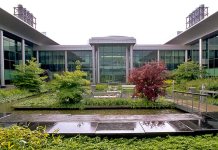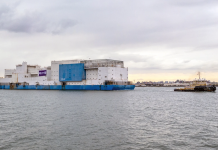Suffolk pioneered its Smart Lab interactive technology center at its New York City office last October, and while it is too early to provide quantifiable data about the concept’s success, company officials are confident they are reducing contingencies, improving project efficiency, and building a more collaborate environment for employees, designers and owners.
The national contractor, with its headquarters in Boston, MA, has deployed the concept in San Francisco, Los Angeles, Miami, Tampa, Dallas and Boston, as well as New York, but the lab at the top of One Penn Plaza was the first to open.
The concept: Use a centralized work area to identify, test and pilot solutions and innovations for the industry.
Charlie Avolio, president and general manager of the company’s NYC office, offered some practical examples of how the Smart Lab has helped manage complex and challenging construction projects.
He cited an example of two buildings Suffolk is building for RAL Companies at Brooklyn Bridge Park Pier Six. One is an affordable apartment structure; and the other is a condominium. Suffolk started work on the apartment building before it had the Smart Lab, so it has a direct comparison between the two construction experiences.
“We’re working on the condo project, now on the 23rd floor,” he said. With the Smart Lab, “we are able to take the data and information from the model to the field, and we are scanning the existing installation for all inserts and openings on the slab, and rebar prior to the placement of the concrete, piloting a program from Avvir.”
“We are doing that digitally with I-Pads and superintendents in the field correlating digital imagery on the scan to the 3D model. If the slab is in the wrong place, exteriors are in the wrong wall, and we find they don’t match the slab openings, we are able to make those corrections before placing the concrete – saving us what might have been re-donewhen working with rulers.”
As well, there are other big savings and enhancements at the pre-construction stage. Their design process is much more collaborative and data-driven, and this means that budgets and schedules can be much more accurately co-ordinated before work starts, he says.
But how much will this really improve the construction process?
“We expect to see contingencies come down,” Avolio said. “Currently we are carrying three to four per cent contingencies. With the Smart Lab process we are able to fill in the gaps in the drawings before we finalize pricing with subcontractors. We expect to reduce the contingency to 1.5 to 2 per cent. Having these things identified ahead of time results in a time saving through the process, with fewer RFI requests, less shop drawing work, and a more complete plans that reduce change orders at the end.”
Chris Mayer, the company’s chief innovation officer, says the Smart Lab has resulted in a “high level of engagement with the workforce and a high level of interest.”
“Very quickly, it turns into a discussion of how we can co-ordinate initiatives and peruse new technologies and migrate them to the project sites,” he said.
Suffolk staff declined to provide specifics about the Smart Labs’ capital costs, noting that it made “significant investments” in these Smart Labs.
A company news release says each lab includes:
-
A data wall: Providing predictive analytics and operational performance indicators to effectively measure critical business areas;
-
A huddlewall: Facilitates Lean pull planning meetings, providing closer collaboration and helping to integrate 3D, 4D and 5D models resulting “in maximum project efficiency and optimized performance;
-
A virtual reality CAVE: Showcases the future by immersing users in sophisticated virtual models. The CAVE (Computer Aided Virtual Environment) “allows clients to virtually ‘step foot inside’ their building before it is built and allows architects and project teams to identify and address logistical challenges before construction begins,” Suffolk says; and
-
Jobsite feeds: Live streaming and time lapse of existing projects, and side-by side comparisons of the current construction phase,
Avolio said “we’re looking at a very long view here.”

The objective is “a long-term sustainable business grounded in customer service and the customer experience, a high level of execution, robust use of technology, developing new relationships with clients, or strengthening existing relationships with clients with the goal of achieving long term repeat clients,” said Avolio.
“We have the ability with our Smart Lab to demonstrate collaboration,” he said. “We can demonstrate things we do with numerous tools at our disposal. It can be as simple as a project meeting, where all data is readily available.”
“There’s a marketing component, but these are the tools we use and this is the way we do business,” he said. “It’s easier to show something and immerse them in the experience, than to tell them what you’re going to do down the road.”
Mayer, meanwhile, said the Smart Lab is part of an initiative to continuously evolve and “scale innovation and change.”
“The Smart Labs are environments where we can change and look and improve and engage not just for tomorrow, but ask ‘What is tomorrow’s tomorrow?’ and build on that.”










